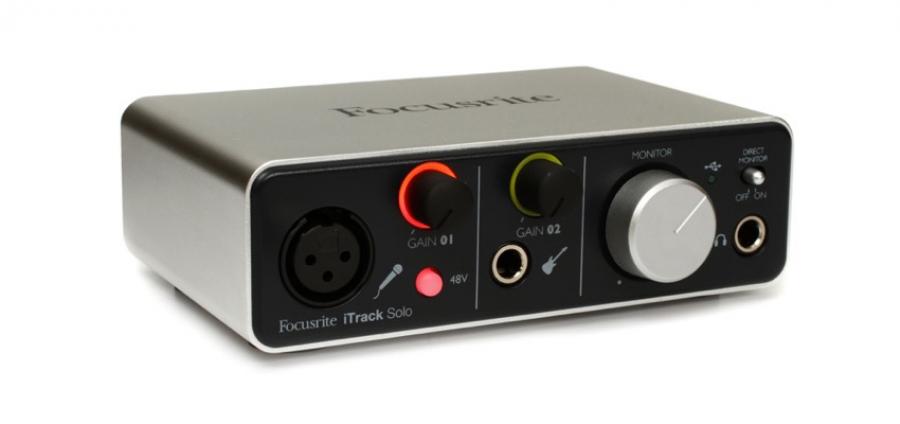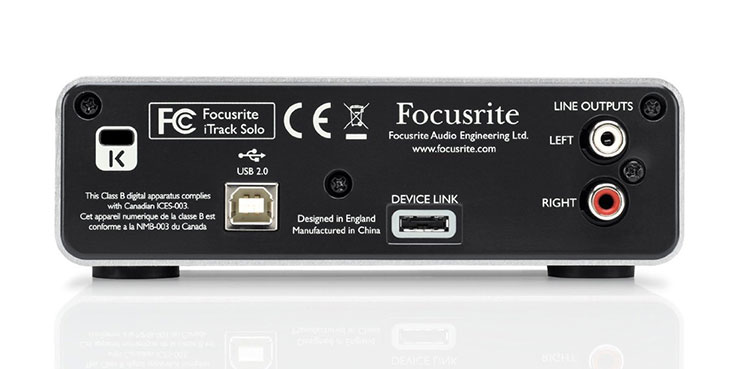
Focusrite iTrack Solo Review
This post has been archived since 30/12/2015.
The following content may contain information which is now incorrect or out of date.
Who is ‘Focusrite’?
Focusrite are a company drenched in studio recording history. Originally founded back in 1985 by non other than Rupert Neve, a legend in the world of electrical engineering, Focusrite’s preamps, compressors and studio consoles have featured on thousands upon thousands of records. Everyone from Sir George Martin to Muse have benefited from Focusrite’s ‘sound’, so chances are your favourite record has too.
In recent years Focusrite’s success has been largely due to their widely popular range of audio interfaces, bringing us to the iTrack Solo.

Overview
The Focusrite iTrack Solo is a 2in/2out USB-based audio interface that allows you to produce that authentic Focusrite ‘sound’ on both your iPad and Mac. It features a microphone preamplifier (with 48v phantom power suitable for condenser microphones), an input for instruments such as guitars and keyboards, stereo RCA outputs and a dedicated headphone output. It offers 96KHz / 24-bit digital-to-analogue / analogue-to-digital conversion, allowing you to reliably capture every nuance that your recordings require.
You can plug in straight into your Mac via USB and as it is class-compliant (meaning it doesn’t require you to install any drivers) then you can even use it with your iPad via a dedicated ‘Device Link’ port.
If you’re using the iTrack Solo on a PC / Mac then you can even make use of the included Ableton Live Lite 8 software. Focusrite even go as far as including their Scarlett plug-in suite, a nice range of audio tools that are certainly worth adding to your arsenal.
Who is it for?
The Focusrite iTrack Solo, through it’s affordability and ease-of-use, is primarily geared towards entry-level users looking for a quality sound, but it could just as easily be useful for professionals needing a compact and semi-portable solution for their recording needs.
It’s perfect for schools too, thanks to its rugged design (more about that soon) and simple installation. With a Mac it doesn’t require any particular software to work (due to it being class-compliant), meaning that schools don’t need to worry about things not being compatible once they’ve updated to a new operating system.
Design
The iTrack Solo feels reassuringly solid to hold. The ‘soft-touch’ aluminium unibody chassis has clearly been influenced by Apple’s Mac and iPad designs - it looks fantastic when you’ve got them working in tandem. Whether it’s being carried around in your backpack or enduring hours of constant use in a busy classroom, the Herculean-design really gives the impression that it’s ready for anything.
The gain and monitor output knobs feel sturdy and allow you to confidently make detailed adjustments. The gain knobs also feature halo signal indicators, making it easy to see when your levels are too high.
You can find a Kensington ClickSafe Lock slot on the rear, making it simple to secure to a desk or work surface. Again, this is certainly a nice touch for security-conscious schools.

Using it
Setting up the iTrack Solo is as easy as unboxing it and plugging into your Mac via USB - a dedicated power supply isn’t required at this stage. Your Mac’s audio settings will need tweaking either via Garageband itself or the Audio / MIDI app. Once done, I simply created a new audio track, pressed record and away I went. The audio interface is only one part of the signal chain and so the quality of sound you hear will also largely depend on what microphone or instrument you’re working with (as well as how you’re listening to it), however, the recordings I made were sonically crisp throughout and without any interference / distortion.
Using it with an iPad took a bit more thought but it is still very easy to setup. You take the included cable and connect it to the ‘Device Link’ port on the back and then connect the other end to your iPad. The iPad doesn’t power the device though (as it does when connected to a Mac) so you will need to use the included USB cable and plug it into a USB power adaptor. I simply used the power adaptor that came with my iPad / iPhone. Once done it really was as easy as opening the likes of Garageband, opening up the Guitar Amp, selecting the correct input and then hitting record. Simple. It works great with other apps too, especially ones that allow you to make use of the iPad’s accelerometer or touch screen to manipulate sound effects with simple gestures, such as Boon’s Vio app.
Likes
I really did enjoy using the iTrack Solo for the most part. Its solid design is reassuring if you’re constantly on the move and it could easily withstand being in the likes of a classroom environment - especially if security is a concern and you need to make use of the Kensington ClickSafe Lock port.
The functionality is immensely simple and, whilst I’m quite versed with this type of technology, someone with no experience whatsoever really wouldn’t find it difficult by any means. The preamp sounds great but, given the affordable price, it’s doubtful that it’ll standup to the more serious (and inherently more expensive) offerings from Focusrite. Still, the sound it produces is sonically clean but still with an element of character.
The plug-and-play approach works great on a Mac as you only need to tweak a few audio settings. It’s even easier on an iPad too as you literally only make sure you’ve got the right input selected.
The fact that it is class-compliant (excluding for PCs) is really attractive too. Schools are often faced with the prospect that their MIDI keyboard controllers or audio interfaces will stop working if they update the OS or replace the machine altogether, and so they often have to stand still in time so as to not break compatibility. With no drivers or special software needed for the iTrack Solo to work, that issue becomes a thing of the past.
Don’t Like
The only real complaint I have about Focusrite’s iTrack Solo is it’s need for external power when using it with an iPad. It would have been fantastic if it came with an option to insert some batteries so as to be able to record even where there’s no access to a power point: a park, the beach, etc. It wouldn’t stop me from buying one but it’s just slightly disappointing that you can’t make use of the iTrack Solo’s small footprint and rugged demeanour without it being connected to a power point.

Conclusion
If you’re a budding musician who needs something simple, consistent and reliable, then Focusrite’s iTrack Solo is for you. If you’re a Mac or iPad user then you won’t necessarily have to worry about it not working with the latest OS X or iOS release and the fact it’s built like a tank makes you wonder whether it’ll ever actually break.
It’s not often that you can get a piece of history at such an affordable price either - Focusrite really do have rich pedigree behind them and their products are generally within reach of most.
Buy it!
No Comments yet. be the first to comment.